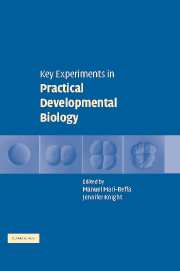Book contents
- Frontmatter
- Contents
- List of contributors
- Preface
- Introduction
- SECTION I GRAFTINGS
- SECTION II SPECIFIC CHEMICAL REAGENTS
- SECTION III BEAD IMPLANTATION
- SECTION IV NUCLEIC ACID INJECTIONS
- SECTION V GENETIC ANALYSIS
- SECTION VI CLONAL ANALYSIS
- SECTION VII IN SITU HYBRIDIZATION
- SECTION VIII TRANSGENIC ORGANISMS
- SECTION IX VERTEBRATE CLONING
- SECTION X CELL CULTURE
- SECTION XI EVO–DEVO STUDIES
- SECTION XII COMPUTATIONAL MODELLING
- 27 Theories as a tool for understanding the complex network of molecular interactions
- Appendix 1 Abbreviations
- Appendix 2 Suppliers
- Index
- Plate Section
- References
27 - Theories as a tool for understanding the complex network of molecular interactions
Published online by Cambridge University Press: 11 August 2009
- Frontmatter
- Contents
- List of contributors
- Preface
- Introduction
- SECTION I GRAFTINGS
- SECTION II SPECIFIC CHEMICAL REAGENTS
- SECTION III BEAD IMPLANTATION
- SECTION IV NUCLEIC ACID INJECTIONS
- SECTION V GENETIC ANALYSIS
- SECTION VI CLONAL ANALYSIS
- SECTION VII IN SITU HYBRIDIZATION
- SECTION VIII TRANSGENIC ORGANISMS
- SECTION IX VERTEBRATE CLONING
- SECTION X CELL CULTURE
- SECTION XI EVO–DEVO STUDIES
- SECTION XII COMPUTATIONAL MODELLING
- 27 Theories as a tool for understanding the complex network of molecular interactions
- Appendix 1 Abbreviations
- Appendix 2 Suppliers
- Index
- Plate Section
- References
Summary
INTRODUCTION
Development is controlled by a highly complex network of interactions in which nonlinear feedback loops play an important role. Our intuition is not reliable to predict the properties of such complex networks. In many branches of natural science theoretical approaches are an integral part to understand the behaviour of complex systems. In this chapter, using the formation of an organizing region as an example, a theoretical approach will be used to determine what type of interactions allow pattern formation, and how one can formulate a hypothetical interaction into a set of differential equations convenient for computer simulations. Finally, the postulated interaction is compared with known experimental observations.
HOW TO GENERATE AN ORGANIZING REGION
In Chapters 1 and 5 the freshwater polyp hydra was discussed as model organism. The hydra hypostome had long been known to be an organizing region (Browne, 1909, Lehnhoff, 1991). Even after dissociation into individual cells, upon re-aggregation complete animals are formed (Gierer et al., 1972), showing that pattern formation is possible even if the initial situation is more or less uniform. We proposed that pattern formation is accomplished by local self-enhancement and long-ranging antagonistic effects (Gierer and Meinhardt, 1972, Meinhardt, 1982). A simple and molecularly feasible realization would consist of two interacting substances. One substance, called the activator, has an autocatalytic feedback on its own synthesis. It controls the production of the second substance, the inhibitor. The inhibitor spreads more rapidly and suppresses the self-enhancement of the activator.
- Type
- Chapter
- Information
- Key Experiments in Practical Developmental Biology , pp. 346 - 354Publisher: Cambridge University PressPrint publication year: 2005



